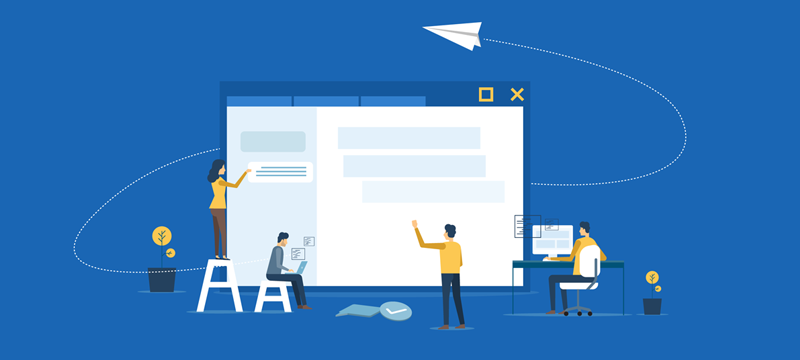You’ll know from your own browsing that some websites are so badly designed that, even if the content is good, you’ll never go back. Giving a visitor a poor experience can kill a website and destroy an online business. Here are 8 of the most critical website mistakes you need to avoid.
- Poor navigation
A good user experience is all about doing things quickly and easily. So, when a visitor lands on your site, they don’t want the hassle of having to spend too much time looking for things or having to constantly press the back button to get to the homepage. A site which doesn’t offer great navigation can be frustrating to users, leading them to abandon it.
To achieve great navigation for your visitors, you need a menu in your header or at the top of your sidebar, a content search bar, breadcrumbs to make it easy to retrace steps, and links to important pages in your footer. The links in the footer should also include a link to a sitemap so that those who are really stuck have a better chance of finding what they want. - Invisible contact details
Some online businesses want all communication with their visitors and customers to be electronic. They’d prefer not to have to deal with telephone calls and letters. However, as a legitimate business, you should put these details clearly on your website. If you are a limited company, you are obliged to show them. These companies lose out because the lack of a physical address or a business number makes customers suspicious and this can have a drastic impact on sales.
There are other companies who want their address and phone number to be seen but don’t make it easy for customers to find them. The easiest solution is to put them in two places. Firstly, they should go in the footer. This way, they will appear at the bottom of every page. Secondly, you should create a contact page which has the details clearly displayed. A link to the contact page should be in the main menu or in the footer. - A headache inducing design
Great website design should be easy on the eye. The design on each page and across pages should be consistent, attractive to look at, easy to read on all devices, have plenty of white space and match your brand.
Unfortunately, some people who build their own websites can often get carried away with the wide choice of fonts and colours at their disposal. What results is a website that is too busy. There are clashing colours, an array of badly chosen fonts (some of which are not supported by every browser) and so little space that the user’s eye cannot take all the information in.
Many users will simply hit the back button, not just because it is chaotic but also because it looks unprofessional. Those that persist will end up with eyestrain and a headache. - Breaking the back button
As a ploy to keep visitors on their website for longer, some webmasters have configured their site so that when a user clicks the back button they find it has been disabled or it takes them to another landing page. This essentially traps a user and prevents them from going back to Google to find a different site.
This form of tactic offers one of the worst forms of user experience. No visitor expects a browser button not to work and this can cause frustration, anxiety and anger. The only solution is to close down the browser tab. After that, you’ll have zero chance of that user ever coming back to visit you. - Opening up a new browsing window
When creating links on your website you are giving the option to open the page in the same tab, a new tab or a new window. The general rule is that if the link is to a page on your own site, it should open in the same tab. If the link is to a different site, open it in a new tab so that the user can still go back to your site easily if needed.
There is no need, however, to open any page in a different window. Doing this essentially opens up two versions of the browser at the same time. Not only does this make for a complex browsing experience, it also uses up much more of the resources on the user’s device, slowing down how well it performs. - Leaving broken hyperlinks on your site
Putting links to pages on your own or other’s sites is extremely helpful to visitors. However, when the pages you have linked to have been removed, what you are left with are links to nowhere. When a visitor clicks on them, all they see is a 404 error page. This can be very frustrating for users, especially if your site has lots of broken links.
The easiest way to prevent them is to use a broken link checker plugin. These will regularly check all the links on your site and notify you if any are broken. For links on your own site, you can choose to redirect them so that customers are sent to newer, more relevant pages. For external links, you can opt to remove them or find alternative URLs to link to. - Obsolete content
Google and visitors like content that is up-to-date and relevant. Websites should be checked regularly to ensure that the information provided is accurate and fit for purpose. For example, if you have a team page on your site and one of your team members moves on, you will need to update that information in case potential customers still try to contact them. If you don’t, you may lose that customer. The same goes for things like addresses, opening hours, product inventory, shipping details, pricing, etc. - Slow loading times
If there is one thing that will force a customer to abandon your site before they even start to read it, it’s a slow loading time. With superfast broadband and 4G networks, internet users expect websites to load more or less instantly. If you’re not fully loaded in a second or so, they’ll be gone. The business will go elsewhere.
There are many things that can cause websites to load slowly and for a detailed understanding, you should always check your site using the Google PageSpeed Insights tool. Key to faster loading, however, is the quality of your web hosting. A great web hosting solution can have a big impact on the speed at which a site loads and, consequently, on the number of sales your website makes. A one second’s delay is estimated to reduce conversion rates by as much as 7%.
Conclusion
As you can see, there are some website management and design errors that can have a very negative effect on your website. These need to be addressed both during the design phase of your site and in its regular maintenance. Hopefully, the information provided here will help prevent you making these critical mistakes.
If you are looking for web hosting that provides quicker loading speeds for your website, visit our homepage to see our range of packages.


